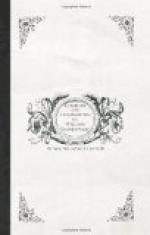The Editor is unable to render adequate thanks to the Rev. Stephen Turnover for the gratification he received in his curious library by a sight of Joseph Carnaby’s name at full length, in red ink, coming from a trumpet in the mouth of an angel. This invaluable document is upon an engraving in a frontispiece to the New Testament. But since unhappily he could procure no signature of Hannah Hathaway, nor of her mother, and only a questionable one of Mr. John Shakspeare, the poet’s father,—there being two, in two very different hands,—both he and the publisher were of opinion that the graphical part of the volume would be justly censured as extremely incomplete, and that what we could give would only raise inextinguishable regret for that which we could not. On this reflection all have been omitted.
The Editor is unwilling to affix any mark of disapprobation on the very clever engraver who undertook the sorrel mare; but as in the memorable words of that ingenious gentleman from Ireland whose polished and elaborate epigrams raised him justly to the rank of prime minister, —
“White was not so very white,” —
in like manner it appeared to nearly all the artists he consulted that the sorrel mare was not so sorrel in print.
There is another and a graver reason why the Editor was induced to reject the contribution of his friend the engraver; and this is, a neglect of the late improvements in his art, he having, unadvisedly or thoughtlessly, drawn in the old-fashioned manner lines at the two sides and at the top and bottom of his print, confining it to such limits as paintings are confined in by their frames. Our spirited engravers, it is well-known, disdain this thraldom, and not only give unbounded space to their scenery, but also melt their figures in the air,—so advantageously, that, for the most part, they approach the condition of cherubs. This is the true aerial perspective, so little understood heretofore. Trees, castles, rivers, volcanoes, oceans, float together in absolute vacancy; the solid earth is represented, what we know it actually is, buoyant as a bubble, so that no wonder if every horse is endued with all the privileges of Pegasus, save and except our sorrel. Malicious carpers, insensible or invidious of England’s glory, deny her in this beautiful practice the merit of invention, assigning it to the Chinese in their tea-cups and saucers; but if not absolutely new and ours, it must be acknowledged that we have greatly improved and extended the invention.




